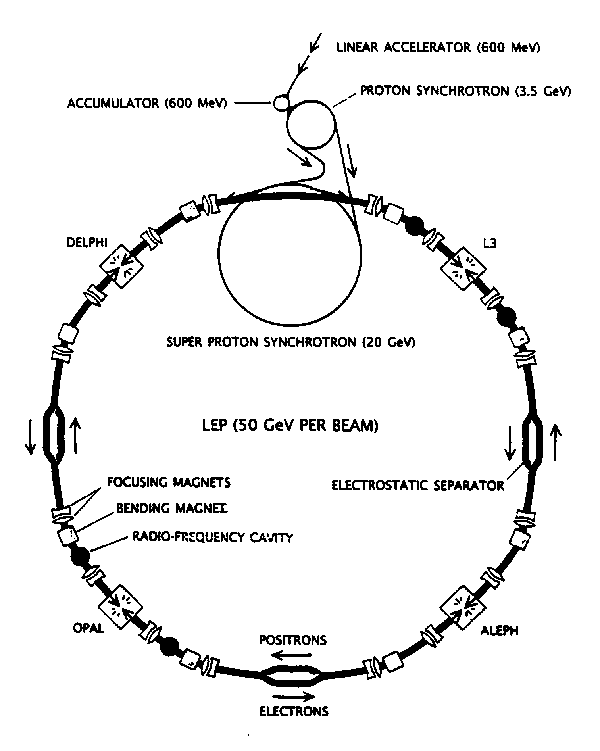
This chapter discusses the details of the operation and working of the LEP electron-positron collider which produces the Z0 particles giving rise to the physics data collected by the OPAL detector. The OPAL detector was designed to provide efficient and unambiguous detection of all types of interactions occurring in e+e-collisions over nearly full solid angle. The main elements of OPAL are the central tracking system with a solenoidal coil magnet, a lead glass electromagnetic calorimeter, a hadron calorimeter, and a muon detection system. The absolute luminosity and identification of low angle particles are achieved through a set of forward detectors. This chapter presents an overview of the main elements of the OPAL detector important for the determination of the number of elementary light neutrinos.

|
The LEP collider consists of an underground tunnel three-quarters of which is situated in French territory and the remainder in Swiss territory. Eighteen access points join the surface areas to the underground tunnel which has an average diameter of about 4.0 m and a depth of 100 m. The actual size of the LEP collider is a compromise between the construction cost and the cost of supplying radio frequency power to make up for the radiated energy lost by the circulating electron and positron. The four bunches of electrons and positrons produce 45,000 beam-crossings per second at the four experimental areas. The integrated luminosity reached by LEP at the end of 1991 corresponded to 20.8 pb-1 resulting in the average production of one Z0 per second, and hence the title ``the Z0 factory''.
The LEP collider is actually the last element in a series of five accelerators which handle production, acceleration, and injection of the electrons and positrons. The layout of the system including the final LEP collider is shown in Figure 3.2 [28]. The first part of the system involves the production and initial storage of the electrons and positrons with the LEP Injector Linac (LIL). LIL consists of two linacs in tandem for producing positrons and electrons in three separate steps. Firstly, 200 MeV electrons are produced from a heated filament and used to create positrons by colliding into a converter. Secondly, positrons are magnetically selected from the electron-positron pairs produced by the converter and accelerated by the LIL to 600 MeV and then transferred to the EPA. Thirdly, with the positron converter out of the beam, the electrons produced from the heated filament are accelerated to 600 MeV by the LIL and then transferred to the EPA.
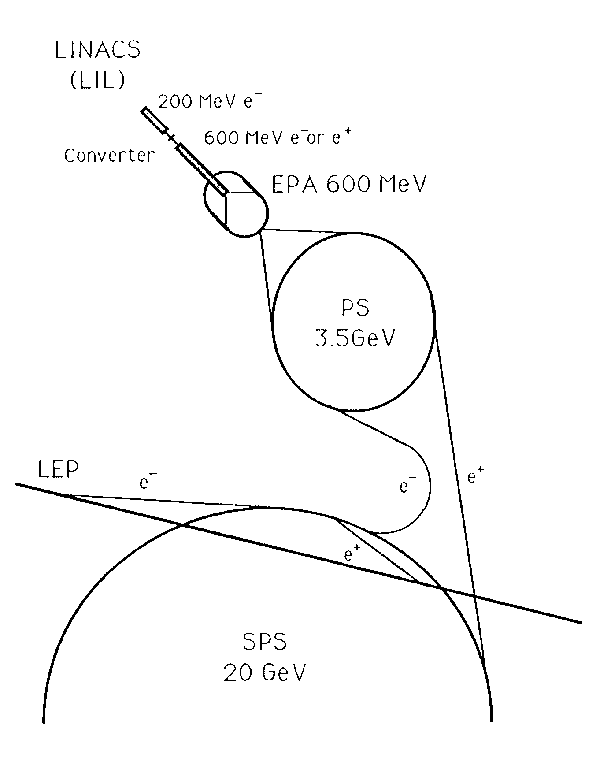
|
The EPA is a circular accelerator 126 meters in circumference used to buffer the electrons and positrons between the fast-cycling LIL (100 Hz) and the slow-cycling Proton Synchrotron (PS) at 0.81 Hz. PS operates as an electron-positron synchrotron accelerating e+e- in opposite directions to 3.5 GeV. The PS then injects electrons and positrons into the CERN Super Proton Synchrotron (SPS) for acceleration to 20 GeV before injection into the LEP collider. Although PS and SPS were originally designed for accelerating protons to 28 GeV and 450 GeV respectively, they were modified to allow the acceleration of electrons and positrons to 3.5 GeV and 20 GeV. In addition, a special multi-cycle mode of operation for PS and SPS allows filling of LEP with little or no effect on the 450 GeV SPS fixed target experiments which run in parallel.
The LEP collider is actually in the shape of an octagon with with rounded corners forming a circular ring 26.658 km in circumference with an average radius of 4.242 km (see Figure 3.1). The collider operates at a nominal beam energy of 45.5 GeV with a design luminosity of 1.6×1031 cm-2s-1. The collider operates with four bunches of electrons and positrons of ~ 4×1011 particles along ±4.0 cm of the beam axis from the origin and 300×20 mm in the x-y direction. The average time between bunch crossings is 22.2 ms with a beam lifetime of 5 h.
The LEP collider consists of a vast array of magnets used for focusing, bending, and accelerating the electrons and positrons. Since positrons and electrons have the same mass but opposite charge, the same arrangement of magnets is used with positrons and electrons circulating in opposite directions. The system of magnets consists of 3304 bending dipole magnets, 816 quadrupole magnets, and 504 sextupole magnets, and 8 superconducting quadrupole magnets. Additionally, there are 616 regular orbit correctors and other magnets such as tilted quadrupole magnets, wiggler magnets, and double field dipole magnets used near the interaction regions. The dipole magnets are 5.75 m long and capable of producing a magnetic field of 0.06 T necessary for guiding 55 GeV beams around the LEP ring with a maximum current of 4.5 kA. The quadrupole magnets are 1.6 m in length and produce a maximum gradient of 9.7 Tm-1 with currents of 300 A. The sextupoles have lengths of 0.4 m and 0.76 m and yield strengths of 180 Tm-2 with currents of 360 A.
The LEP beam chamber has been evacuated to minimize the chance of beam-gas interactions. The vacuum pressure is required to be 10-11 torr when LEP beam is not present to ensure that the ambient vacuum of 10-9 torr is achieved during operation from the resulting ``bake-out'' due to the synchrotron radiation. This vacuum is obtained in a two step process: first, mobile rotary vane and turbo molecular pumps are used to achieve a starting vacuum of 5.0×10-4 torr, and second, the main pumping system consisting of non-evaporable getter (NEG) and sputter-ion pumps reduce the vacuum to 10-11 torr.
This internal pressure allows a reasonable beam current to be maintained in the LEP ring for several hours before refilling. To compensate for the synchrotron dissipation of particle energy, a system of 128 radiofrequency (RF) accelerating cavities powered by 16 klystrons is installed in some of the straight sections of the LEP ring. During periods of the operating cycle when there are no particles in the accelerating cavities, the power is transferred into the spherical cavities. In this way, the RF system is able to store and save energy to use for raising the beam energy from the 20 GeV from the SPS to about 46.5 GeV during operation. The synchrotron radiation emitted by the electrons and positrons is also absorbed by the beam walls resulting in a large amount of thermal energy. This heat is carried away by a water-based cooling system adjacent to the beam pipe as shown in Figure 3.3 [29].
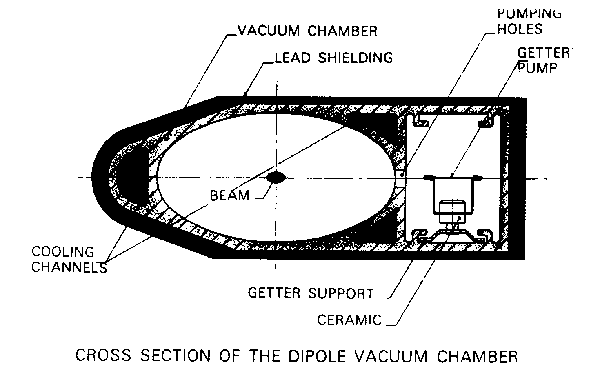
|
The initial performance of LEP (LEP1 phase) has been spectacular in many respects. During the initial running of LEP, a peak luminosity of 6.8×1030 cm-2 s-1 has been delivered to each experiment producing one Z0 every second. In a few years, LEP is expected to start the second phase of running (LEP2) [29] allowing center-of-mass energies of up to 200 GeV for the study of W± pair production. To achieve this, LEP is expected to upgrade the conventional copper accelerating cavities with superconducting niobium-plated copper accelerating cavities. These cavities dissipate less power and allow higher beam energies providing the desired center-of-mass energy.
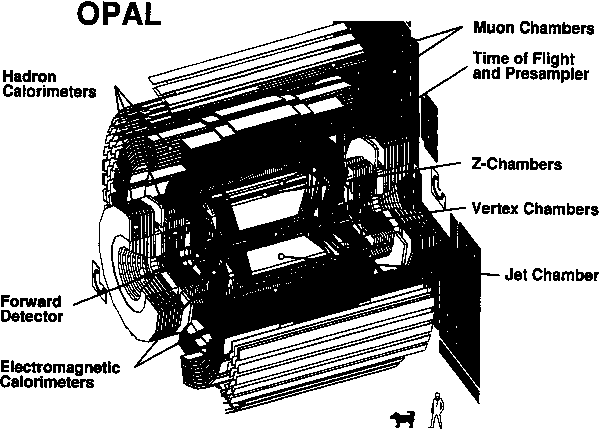
|
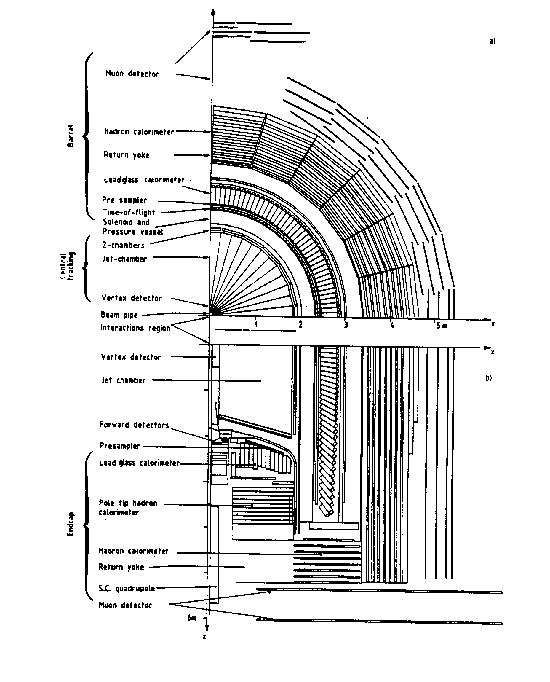
|
| Subdetector | Composition and Coverage | Features |
| Beam Pipe | Al Pipe, d=0.1 mm | LowX0=23.5 cm |
| Layers of Carbon Fiber | ||
| ri=78 mm | ||
| Vertex | 36 Axial(Stereo) Sectors, | sr-f=55mm |
| Chamber | with 12(6) Wires/Sector | |
| l=1 m, rin(out)=8.5(23.5) cm | ||
| |cosq| < 0.95(0.91), Axial(Stereo) | ||
| Jet | 24 Sectors, 159 Wires/Sector | sr-f=135mm |
| Chamber | l=4 m, rin(out)=24.5(185) cm | sz=6 cm |
| 43° £ q £ 137° | ||
| Z-Chamber | 24 Chambers, | sr-f=135mm |
| 8 cells/chamber, 6 Wires/Cell | sz=100-350 mm | |
| l=4 m, rin(out)=188(196) cm | ||
| 44° £ q £ 136° | ||
| Magnet | Weight = 2800 tons | Non-uniformity < ±0.5% |
| l=6.3 m, r=2.18 m | ||
| Amax=7000 A, B = 0.435 T | ||
| Presampler | 16 Chambers | Shower ID. from Coil |
| Barrel | l=6.62 m r=2.39 m | |
| Time-of-Flight | 160 Scintillation Counters | Charged Particle ID. |
| (TOF) Barrel | l=6.84 m, < r > =2.18 m | Engy Range 0.6-2.5 GeV |
| |cosq| < 0.82 | Cosmic Ray Veto | |
| Electro | 9440 Lead Glass Blocks | e+, e-, and g Shower Det. |
| -Magnetic | l=6.62 m, r=2.46 m | 50-100 GeV |
| Calorimeter | |cosq| < 0.82 | Discriminate p0 vs. g |
| Barrel (EB) | Discriminate hadron vs. e | |
| Hadron | 9 Layers of Chambers | Measure Hadron Energy |
| Calorimeter | l=6.62 m, rin(out)=3.39(4.39) m | Help m ID. |
| Barrel (HB) | |cosq| < 0.82 | |
| Muon | 110 Drift Chambers, | m ID. |
| Barrel (MB) | and 2 Wires/Chambers | |
| l=10.0 m, rin=5.0 m | ||
| |cosq| < 0.93 |
The OPAL coordinate system is illustrated in Figure 3.4; the x-axis is horizontal and points towards the approximate center of LEP, the y-axis is approximately vertical, and the z-axis is in the electron beam direction. The polar angle, q, is measured from the z-axis, and the azimuthal angle, f, from the x-axis about the z-axis for tracks as they leave the jet chamber. Additionally, the beam and the solenoid axis are inclined at an angle of 13.9 mrad relative to the horizontal plane at the OPAL interaction region.
Briefly, the OPAL detector performs tracking of charged particles with the central detector consisting of a precision silicon microvertex detector, a vertex chamber, a large volume jet chamber, and Z-chambers for measuring the z-coordinate. The silicon microvertex detector gives primary vertex tracking in the region |cosq| < 0.83 for the inner layers and |cosq| < 0.77 for the outer layers. The next detector encountered is the central detector consisting of three sets of drift chambers: a high precision vertex chamber, a large-volume jet chamber and ``Z-chambers'' which give a precise z measurement in the barrel region. The jet chamber is divided into 24 azimuthal sectors each containing 159 sense wires. The central detector is positioned inside a solenoidal coil of 1.81 radiation lengths,X0, in thickness which provides a uniform magnetic field of 0.435 T. This provides measurements of particle direction and momentum within the central detector. The momentum resolution of the tracking chambers is measured to be Dp/p » 6.8% for e+e-® e+e-m+m- events with a transverse beam momentum of ~ 45 GeV. In addition to tracking charged particles, the jet chamber provides measurements of the ionization loss of charged particles, dE/dx, which are used for particle identification. The optimum dE/dx performance of the jet chamber is D(dE/dx)/(dE/dx) = 0.030 for an isolated track of 159 points.
The coil is surrounded by a time-of-flight counter array (TOF) and a lead glass electromagnetic calorimeter (ECAL) with a presampler (PRES). The electromagnetic calorimeter consists of a cylindrical array of 9,440 lead glass blocks of 24.6X0 thickness, covering |cosq| < 0.82 in the barrel region, and 2,264 lead glass blocks of 20X0 thickness in the endcap regions, covering 0.81 < |cosq| < 0.98. The electromagnetic calorimeter yields an energy resolution of DE/E » 3% for e+e-® e+e-e+e- events with E » 45 GeV in the barrel region. Each block subtends a solid angle of approximately 40 mrad×40 mrad and projects towards the interaction region in the barrel region and along the beam direction in the endcaps. The two sections of the electromagnetic calorimeter together cover 98% of the solid angle. In the barrel region, the amount of material in front of the ECAL is ~ 1.78 X0.
Outside the electromagnetic calorimeter is the magnet return yoke instrumented with nine layers of streamer tubes serving as a hadron calorimeter (HCAL) and a muon tracker. The HCAL streamer tubes consist of 4 mm wide strips spaced 1 cm apart and projective towers formed from 50 cm×50 cm pads. These strips and pads provide measurements in the r-f plane and the z-direction. Located just outside are four layers of muon drift chambers (MUON) used for muon detection. In the very forward directions with respect to the beam axis are the forward detector calorimeters between 40 and 120 mrad used for detection of low angle Bhabha events for the luminosity measurement.
At the experimental site, I6, hardware for the maintenance, operation, and data acquisition is located on the surface and underground with the OPAL detector. The OPAL detector itself is surrounded by a number of electronics rooms containing special electronics necessary to control, monitor and readout each of the OPAL subdetectors. The rooms attached to the near side of the detector are RN1, RN2, and RN3, while the rooms located on the far side of the detector are RF2 and RF3. Suspended above the detector in the main experimental area are additional electronics rooms in the upstream-beam direction (GO1 and GO3) and the downstream-beam direction (GO2 and GO4). Chapter 4 discusses the importance of these electronics rooms with respect to the operation of the data acquisition system. Finally, the OPAL detector also has a rail and roller system to allow the displacement of the two halves of the 2800 ton detector from the beam line to give access to the inner parts of the detector when the LEP machine is not functioning.
The magnet system consists of a solenoidal coil and an iron yoke of soft steel plates with a radius of 2.18 m and a length of 6.3 m. The 25 ton solenoidal coil produces a central field of 0.435 T operating with about 5 MW of power which is cooled by a self-contained water system. The solenoid contains 96 mm of aluminum and 54 mm of glass epoxy (equivalently 1.7X0). The return yoke can be broken down into five main parts; a central part, two ``C''s, and two pole tips, all of which is moveable from the beam line through a system of rails and rollers as shown schematically in Figure 3.6 [30]. The return yoke is instrumented to serve as a barrel, endcap, and pole tip hadron calorimeter.
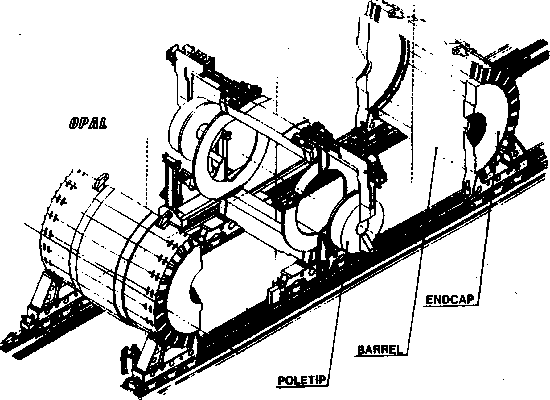
|
The central vertex detector (CV) [31] is a 1 m long cylindrical drift chamber used for primary tracking in the range |cosq| < 0.95. The chamber has an inner radius of 8.8 cm and an outer radius of 22.75 cm and is enclosed in the central tracking system pressure vessel. The chamber consists of 12 layers of axial wires and 6 layers of small angle (4°) stereo wires both with 36 cells in f. The axial wires are separated by 5.3 mm radially in the range from 103 to 162 mm, while the stereo wires are separated 5.3 mm radially in the range from 188 to 213 mm as shown in Figure 3.7 [32]. Anode planes consist of alternating 200 mm diameter gold plated Cu-Be wires and 20 mm diameter gold plated W-Rh wires staggered by ±41 mm in order to resolve the left-right ambiguities. In addition, the 2.5 kV chamber voltages induces an anode wire bow of 50-100 mm. The active gas used in CV is the same as that used in the jet chamber, 88.2% Argon (Ar), 9.8% Methane (C4H6), and 2.0% Isobutane (C4H10) at an absolute pressure of 4 bar.
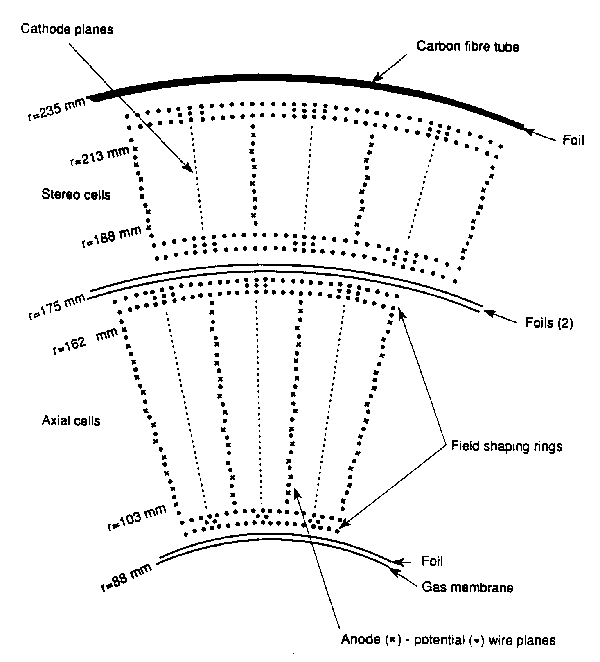
|
With a maximum drift time and distance of 0.5 ms and 1.4 cm, the drift time measurement of the axial cells determine the position of a particle's trajectory to within with sr-f=50 mm in the r-f plane and sz=4 cm in the z-coordinate along the wire. The z-coordinate, obtained by measuring the time difference between the signals from the two ends of the anode wire, is used in the fast track trigger and for offline track finding. The combination of stereo and axial cell information provides an accurate z measurement of sz = 700 mm resolution for charged particles close to the interaction region. A double hit resolution of 2.0 mm gives good two-track separation.
The central jet chamber (CJ) is a 3.7 m long cylindrical sensitive volume of wires surrounding CV used for tracking with good space and double track resolution as shown in Figures 3.8 3.9 [30]. CJ spans from 25.0 cm to 185.0 cm in radius with an angular range of 43° < q < 137° for 159 measured points along each track. The sensitive volume is composed of 24 identical sectors each containing 159 sense wires stretched between conical endplates spaced from 25.0 cm to 183.5 cm radially. The signal wires alternate with potential wires being equally spaced by 10 mm and staggered by ±100 mm on either side of the plane formed by the wires in order to resolve the inherent left-right ambiguities. The wires are parallel to the beam direction with the wire planes radially oriented to combine good space and double track resolution similar to the drift chamber design used by the JADE experiment of PETRA [33].
The precision of the system relies on optimization of the gas properties such as drift velocity and stable operation of the drift region. The signal wires are at ground potential, while the potential wires, which are alternate with the same plane as the signal wires, are held at -2.38 kV. The other field shaping electrode and cathode wire planes are held at potentials ranging from -2.5 kV to -25 kV and constantly monitored to protect against short circuits. The active gas used in CJ is the same as that used in CV with the working point of gas gain, 104, with drift fields of 890 V/cm at a pressure of 4 bar. The 3816 signal wires are read out from both ends and recorded by 100 MHz flash analog-to-digital converters (FADC) with 6 bit resolution.
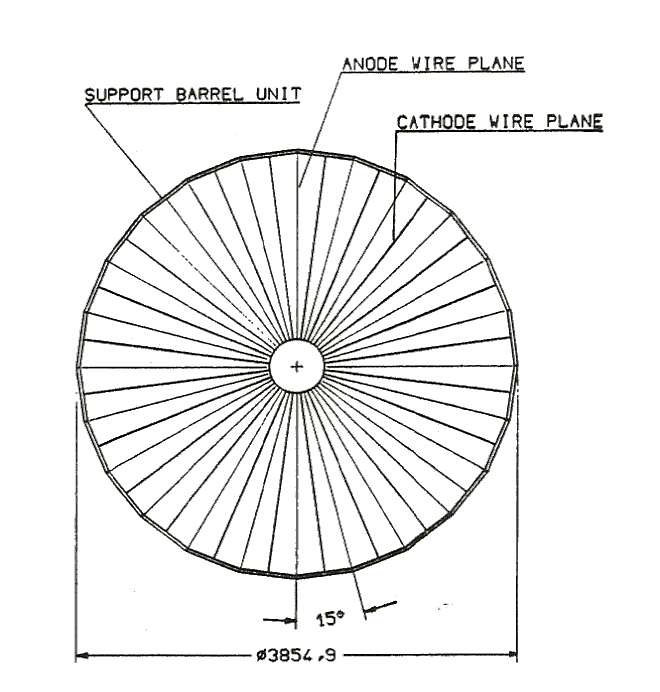
|
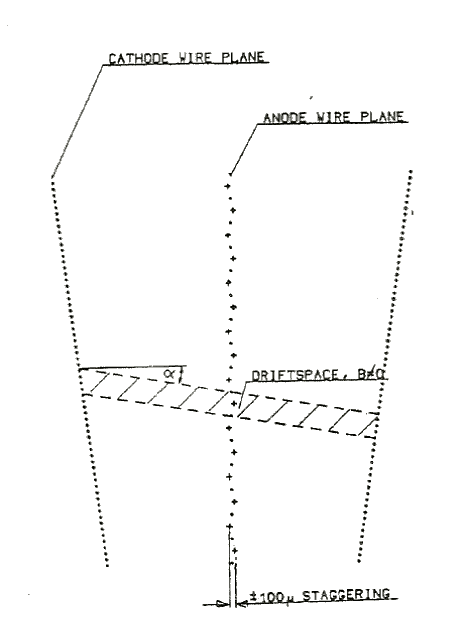
|
For each point, the true three-dimensional coordinate (r, f, z) is determined from the wire position, the drift time, and the charge division measurement. The charge division measurement requires the integrated charges for each hit at both ends of the signal wire, namely q1 and q2. The ratio of these charges, (q1-q2)/(q1+q2), determines the z coordinate while their sum, q1+q2, yields the energy loss, dE/dx as shown in Figure 3.10 [32]. The track momentum, p, is measured from the track curvature, k in (cms)-1, and tan l as follows
| (3.1) |
where l = cotq, with q the track polar angle measured from the z-axis and a = [(c)/2] ×10-14. With important effects like mechanical staggering (Dmech. = ±100 mm), electrostatic deflection (Ddefl.max = + 60 mm), gravitational sagging (Dgrav.max = + 200 mm), and the drift velocity (vD = 52.7 mm/nsec) calibrated and included, the spatial resolution in r-f is 135 mm over a mean drift distance of 7 cm. The space resolution in the z-direction is measured to be 6.0 cm yielding a resolution of sp/p2 = 2.2×10-3 (GeV/c)-1. The truncated mean energy loss, dE/dx, for muon pair events with at least 130 points per track gives a resolution of sD(dE/dx)/(dE/dx) of 3.8%.
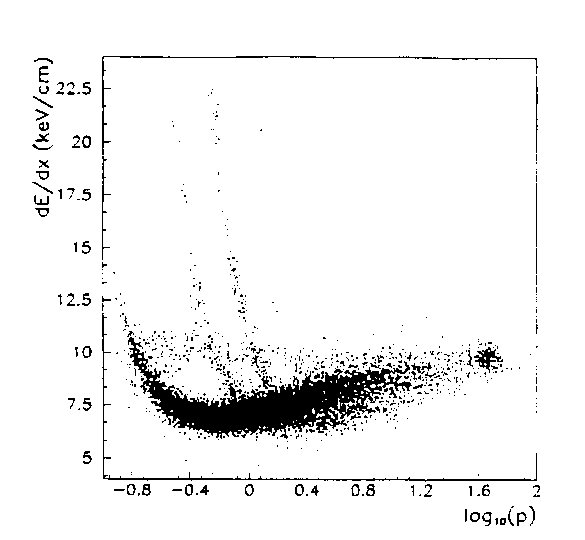
|
The Barrel Electromagnetic Presampler
The barrel electromagnetic presampler (PB) is a cylindrical array of tubes divided into 16 sectors covering an angular range corresponding to |cosq| < 0.81. Each sector is situated at a radius of 238.8 cm from the beam axis with a length of 662.3 cm and composed of 2 layers of 24 cells of limited streamer mode tubes as shown in Figure 3.11 [30]. Each cell is a 9.6 mm square separated by 1 mm thick PVC walls with a 75 mm thick stainless steel anode wire running parallel to the beam axis through the center of the cell. Accompanying the anode wire are cathode strips of 1 cm width on both sides of each layer of the tube oriented at 45° to the anode direction. The streamer position is sensed from the charged induced on cathode strips. The z-coordinate is then measured by charge division of the charge collected at both ends of the anode wire. Each cell operates with a gas mixture of 32% N-Pentane (C2H9) and 68% CO2. PB also provides a precise measurement of the converted photon position with a resolution for an electromagnetic shower varying from 4 to 6 mm (2.4 to 1.7 mrad) as the energy decreases from 50 to 6 GeV. The resolution in the z-coordinate from charge division is 10 cm.
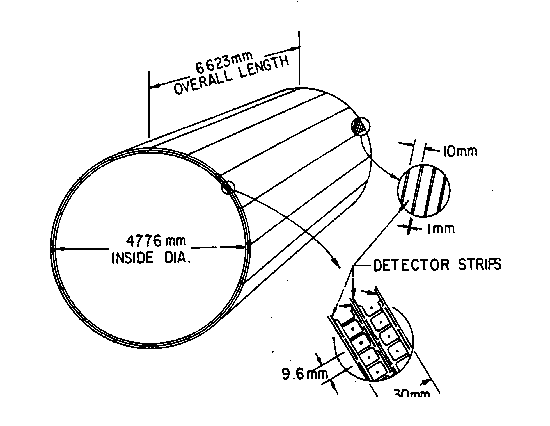
|
The Endcap Electromagnetic Presampler
The endcap electromagnetic presampler (PE) [34] is an umbrella shaped arrangement of 32 thin multi-wire chambers operating in a high gain mode between the containment vessel of the central detector (pressure bell) and the lead glass blocks of the electromagnetic calorimeter endcaps. PE is divided into 16 azimuthal sectors covering an angular range 0.83 < |cosq| < 0.95. PE functions similar to the hadron pole tip described in Subsection 3.2.6 to provide an energy correction to the electromagnetic energy and determine the spatial coordinates by simultaneous readout of 4 adjacent wires and two layers of cathode strips.
The Barrel Electromagnetic Calorimeter
The barrel electromagnetic calorimeter (EB) is a quasi-pointing array of 9,440 lead glass blocks just outside the magnet at a radius of 245.5 cm covering an angular range of |cosq| < 0.82 with full azimuthal coverage. Mechanically, EB is divided into 10 half-ring structures containing 80 identical f-segment modules of 12 lead glass counters. The array of the lead glass blocks is segmented into 59 blocks along the z-coordinate and 160 blocks in f as shown in Figure 3.12 [29]. The array uses blocks of 16 different shapes tilted by 0.574° in such a way that the gaps point away from the beam axis by 30 mm. This quasi-pointing geometry minimizes the probability of a particle traversing more than one block, while preventing neutral particles from escaping through the gaps between blocks (less than 1 mm). The lead glass is composed of a special type of material called SF57 3 with 75% PbO by weight and X0=1.5 cm.
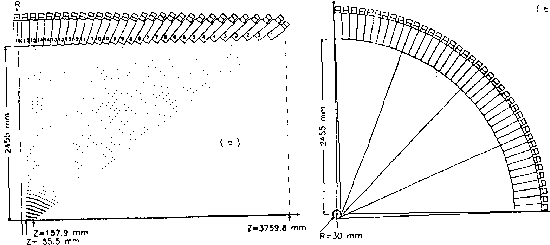
|
Each lead glass block measures ~ 10 cm ×10 cm in cross-section and 37 cm in depth (24.6X0) and is coupled to a photomultiplier tube (PMT)4 through a lightguide. Each block is individually wrapped with a black sheet of vinyl fluoride laminated with a polyester film and coated with a Permaloy metal5 on the inner surface for efficient reflection of light. The PMT is used to view the Cerenkov light produced by relativistic charged particles in the blocks and is stable in external magnetic fields of up to 100 Gauss with more than 99% in gain. The external magnetic field near the PMTs is typically 20-30 Gauss with gains in excess of 99%. The assembly of the lead glass block with lightguide, phototube, and fiber optic connector is shown in Figure 3.13 [30].
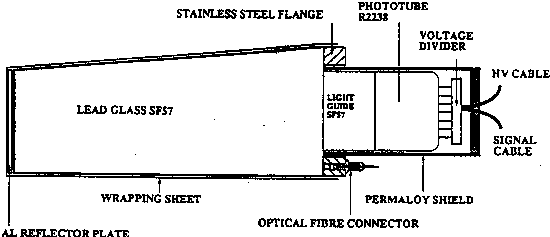
|
The lead glass blocks are operated at -1.0 kV with a PMT gain of ~ 1.0 ×105 with an average channel noise of ~ 2 MeV. Signals from the phototubes are digitized by charge integrating FASTBUS ADCs using two sensitivities, 30 fC/count and 225 fC/count, to assure a high precision measurement over a wide range of energies. The intrinsic energy resolution is sE/E » 0.2%+6.3%/ÖE, where E is the measured electromagnetic energy in GeV, and the spatial resolution is 11 mm for an electromagnetic shower.
The Endcap Electromagnetic Calorimeter
The endcap electromagnetic calorimeter (EE) consists of two convex shaped arrays of 1,132 lead glass blocks located between the pressure bell of the central detector and the pole tip hadron calorimeter covering 0.81 < |cosq| < 0.98 and the full azimuthal angle. EE differs from the EB in two important aspects: the lead glass blocks in EE are made from different material and the blocks in EE are mounted coaxial to the beam line. Vacuum phototriodes (VPT) in EE, capable of operation up to the full axial field strength of 0.4 T, are used to detect Cerenkov light. Each lead glass block is composed of CEREN-25 containing 55% PbO by weight withX0 = 2.51 cm and come in three lengths (38.0, 42.0, and 52.0 cm) providing a depth of at least 20.5X0 (typically 22X0). Each block is wrapped with a mylar coated aluminum foil for efficient reflection of light and housed in a brass can of wall thickness 0.45 mm to screen the block electrically and give mechanical support to the entire assembly.
Single stage VPTs are used to convert the light from the electromagnetic showers into electrical signals. The VPTs are operated at -1.0 kV with a gain of ~ 12.3 and an average channel noise of ~ 14 MeV. The signals from the VPTs are amplified by high gain, low noise amplifiers and fed into the same type of charge integrating FASTBUS ADCs used in the EB. The energy resolution is sE/E » 5%/ÖE, where E is the electromagnetic energy (GeV) with a spatial resolution of 8 to 14 mm for an electromagnetic shower from 6 GeV electrons at 15°.
Barrel and Endcap Hadronic Calorimeters
The barrel hadronic calorimeter (HB) consists of 9 layers of chambers, alternating with 8 slabs of iron and spans from 3.39 m to 4.39 m in radius over the angular range of |cosq| < 0.81 with full azimuthal coverage. The endcap hadronic calorimeter (HE) is made up of two doughnut shaped arrays of 8 layers of chambers, alternating with 7 iron slabs, over the angular range 0.81 < |cosq| < 0.91 with nearly full azimuthal coverage. The slabs in HB are 10.0 mm thick with 2.5 mm gaps, while in HE they are 10.0 cm thick with 3.5 cm gaps. The active elements of the detector layers are the limited streamer tubes constructed from PVC extrusion with 7 or 8 cells 10 mm wide with a 100 mm BeCu anode wire in each cell. The cells have a cross-section of 9 mm×9 mm with a wall thickness of 1 mm enclosed in an uncoated PVC gas envelope. The inside surface of each cathode cell is coated with graphite and a stabilizer while the fourth side is open. The operating drift voltage is between 4.65 kV and 4.85 kV with a gas mixture of gas mixture of 75% Isobutane (C2H6) and 25% Argon (Ar) at atmospheric pressure.
The signals from the streamer chambers tubes are read out on the inner face through large area copper pads, 50.0 cm×50.0 cm, and on the outer face by large aluminum strips, 4 mm wide parallel to the beam and centered over the anode wire. The signals from the 57,000 anode wires are also read out, but are only used for monitoring purposes. Layers of pads are grouped together to form towers, which divide the solid angle into 976 equal elements radiating from the interaction region. There are a total of 800 active towers in 48 bins of 7.5° in f and 17 bins of 5.0° in q in the HB. There are a total of 176 active towers in HE divided into 48 bins of 7.5° in f and 4 bins of 5.0° in q. Space needed for structural support of the detector prohibits the deployment of 16 towers.
Strip signals are sequentially read with 72 locally mounted shift registers with zero suppression. The total number of strip hits in a hadronic shower is a linear function of the incident hadronic energy, provided that the number of particles traversing each hit cell is close to one. Tower signals are read with 72 local shift registers and digitized with 12-bit ADCs twice due to the offset in gain from the strips by a factor of eight. Tower signals are then summed from the 8 or 9 pads in each tower and provide an estimate of the energy of hadronic showers.
The overall hadronic energy is determined by combining signals from the electromagnetic and hadronic calorimeter since there is the 2.2 lI of absorber in front of the HCAL due primarily to the ECAL. The sampling thickness of 10.0 cm gives an approximate match between the uncertainties in hadronic energy measurement from the HCAL and the 2.2 lI of material from the ECAL. For the precise identification of muon tracks, the important parameters are the positional accuracy (limited by the 10 mm wire spacing) and the hit multiplicity efficiency for single minimum ionizing particles. Certain inefficiencies such as the geometrical inefficiency of 10% and the spurious cross-talk must also be considered in assessing the tracking. The HB and the HE have a muon finding efficiency of 80% and a hadron rejection factor of 8 by requiring samples to have fired in at least 6 of 9 (8) HB (HE) layers. A typical hadronic shower from a pion of 10 GeV produces about 25 strip hits and generates a charge of about 600 pC with an energy resolution of sE/E » 120%/ÖE.
The hadronic pole tip calorimeter (HP) complements the HB and the HE by extending the angular coverage from |cosq| < 0.91 to |cosq| < 0.99. The active elements of the HP consist of 7 mm multi-wire chambers operating in a high gain mode, similar to the PE chambers mentioned in Section 3.2.4. The chambers consist of an anode plane with 50 mm wire spaced every 2 mm and located 3.2 mm from the cathode planes. The HP has two sizes of chambers: one has 13 pads and 32 strips covering an area of 0.61 m2, while the other has 8 pads and 28 strips over an area of 0.47 m2. The chamber wires operate at a voltage of 3.5 kV in a gas mixture of 32% N-Pentane (C2H8) and 68% CO2. The strips fan out radially with a dead area of 12% for each layer due to the gas lines and support. The ADCs record the summed pulse height for each tower and strip.
A good estimate of the energy of a hadron can be rendered by the weighted sum, EHCAL + R×EECAL - assuming the particle is a hadron (electron) - using R (the e/p ratio) of ~ 3 at 6 GeV and ~ 2 above 20 GeV as determined from data. With this parameterization, the combined energy response is consistent with being linear and the energy resolution varies from 100% / ÖE for energies below 15 GeV to 140% / ÖE at 50 GeV.
The misidentification of hadrons is due to three distinct hadronic processes: sneak-through (failure to interact strongly), punch-through (secondary particles emerge), and decay in flight of pions and kaons to muons. Decay is important at low momenta, punch-through at high momenta. Although some misidentification is inevitable, other misidentification can be prevented by more accurate track track matching. To reduce the misidentification, the particles emerging from the muon detector pass through a minimum of four layers. The probability that an isolated pion of 5 GeV is misidentified as a muon is less than 1%. The efficiency for detecting isolated muons above 3 GeV and within 93% solid angle is essentially 100%.
The barrel muon detector (MB) consists of 110 large area planar drift chambers at a radius of 4.6 m from the beam covering an angular range of |cosq| < 0.72 with at least one layer. Each chamber is 1.2 m wide and 9.0 cm deep and either 10.4, 8.4, or 6.0 m long to fit between the magnet support legs. The four layers of chambers are typically staggered 50 mm in f with respect to each other to resolve the left-right ambiguities and to provide drift time check-sums sensitive to the drift velocity and relative positions. The drift volume of each chamber is composed of two cells, each with a 50 mm anode wire spanning the entire chamber length and parallel to the z-axis. Cathode pads in the shape of diamonds are situated opposite the anode wire plane to determine the z-coordinate of the tracks [35].
The chamber operates in a gas mixture of 10% Ethane (C2H7) and 90% Argon (Ar) with the cathode pads at a voltage of +4.0 kV and the anode wires at +5.85 kV. The resulting average drift field of 13.4 V/mm over a maximum drift distance of 297 mm supports drift velocities of 38 mm/ms leading to maximum drift times of 8 ms. The signals are decoupled from the high voltage, amplified, and digitized with time projection digitizers (TPD) [36]. The muon detector records six different types of signals including: two signals from each end of the anode wire and four from the cathode pads. The f-coordinate is determined by the drift time to an accuracy of better than 1.5 mm, while the z-coordinate is determined by the cathode pads to an accuracy of 2 mm through a three stage process (coarse, medium, and fine z determination).
The endcap muon detector (ME) consists of two sets of large area streamer tubes stacked four layers deep at each end of the detector in the angular range 0.67 < |cosq| < 0.98. Each endcap consists of 8 quadrant chambers 6 m×6 m in area and 4 ``patch'' chambers 3 m×2.5 m in area covering a total area of ~ 150 m2. The quadrant chambers overlap vertically but not horizontally as space is taken by the beam pipe, cables, and other mechanical supports for the pole tip. The ``patch'' chambers are used to overlap with the quadrant chambers to give full coverage in the angular range 0.67 < |cosq| < 0.98. The two layers of streamer tubes are arranged so that one layer has vertical wires and the other horizontal wires with a separation between the chambers of 670 mm.
Each streamer tube consists of 1 mm thick extrusion in the form of 8 contiguous square sections 9 mm×9 mm in area that serve as the cathode pad. Anode wires 100 mm in diameter every 10 mm run the full length of the chambers. The anode wires operate at a high voltage of +4.3 kV and employ a mixture of 75.0% Isobutane (C4H10) and 25.0% Argon (Ar) at atmospheric pressure. The 42,496 aluminum strips each 8 mm wide with a gap of 2 mm run perpendicular to the direction of the anode wires on one side and along the wires on the other side. This configuration of wires and strips allows the x and y-coordinates of the track to be determined. The streamers are detected by the charge induced on planes of aluminum strips and read out in groups of 32 to a multiplexed 12-bit ADC. The x-coordinates are measured with a resolution of ~ 1 mm by strips perpendicular to the wires, while the y-coordinates are measured with a resolution of ~ 3 mm by strips parallel to the wires.

|
The forward detector was designed to define precisely an inner edge of acceptance in polar angle q and to measure precisely the energy of Bhabhas by requiring collinear events. In the angular range of luminosity measurement, a particle from the origin traverses the 2 mm beam pipe and a 2 mm aluminum window of the central detector pressure vessel (up to 0.4X0), hence allowing measurements of absolute luminosity to ±0.6%.
The forward calorimeter (FD) is composed of 39 layers of 3.4 mm lead and 6.0 mm scintillator (24X0) over a clean acceptance of 47-120 mrad in polar angle outside of the pressure vessel and the beam pipe support structure. The FD is divided into two parts: the pre-radiator and the main calorimeter. The pre-radiator comprises the first 4X0 and is read out only on the outer edge. The main calorimeter is just behind the pre-radiator and has both inner and outer wavelength shifter to vacuum phototetrodes with charge-sensitive preamplifiers [37] and charge integrating ADCs [38] with 48 readout channels per end. Except for the 10 mm gap along the vertical axis for mechanical construction, there is full coverage in f.
At the energy of LEP, the cross-section for Bhabha scattering into the whole area of the main calorimeter is about 57 nb. Studies of Bhabha events show that the energy response is linear and the resolution is consistent with sE/E » 17%/ÖE. The radial position resolution for electron showers is ±2 mm, while the azimuthal resolution is ± 1.5°.
The gamma catcher is a small ring of lead-scintillator calorimeter designed to cover a small gap in the angular region 142-200 mrad between the forward calorimeter and the endcap electromagnetic calorimeter to recover photonic events which would be lost. The lead-scintillator sandwich is 7X0 thick with wavelength shifter read out to silicon photodiodes. Charge sensitive amplifiers deliver a signal that is linear in response for electrons up to 5 GeV. The gamma catcher is intended to provide a veto on background events to the neutrino counting channel e+e-® Z0 g, with Z0 ®n[`(n)] for electrons or gamma rays with Eg > 2 GeV.
The forward drift chambers are composed of two layers of drift sense wires mounted on the front of the fine monitor and immediately in front of the calorimeter plate 250.0 cm from the origin. The forward drift chambers are designed to give a precise measurement of the position of charged particles entering the calorimeter providing a sample of clean events with a precise position measurement. The sample can be used to calibrate the position of other parts of the forward detector less sensitive to showering effects. Each layer has four chambers with two gas gaps with two sense wires per gap with 12 channels for read out via FADC modules [39]. Radial positions are measured from the drift time, and azimuthal positions are measured using a system of intersecting pads on the faces close the wires. From cosmic ray and beam tests, the drift chamber resolution in the drift direction is 300 mm and the resolution along the wire axis is 1 mm.
The Proportional Tube Chambers
The proportional tube chambers consist of three planes of proportional tube chambers located between the pre-radiator and the main sections of the calorimeter. The tube chambers provide the most accurate absolute determination of the luminosity with the normalization of the Z0 resonance curve depending directly on the results. Shower fluctuations after 4X0 of pre-radiator give errors of ± 3 mm on individual shower positions.
The fine luminosity monitor consists of four pairs of scintillators at each end of the forward detectors and about 20.0 cm in front of the calorimeter front face covering the angular range 50-109 mrad from the beam axis over 36% of the azimuthal range. Each scintillator is composed of 6 mm thick NE102 scintillator and connected via a perspex lightguide to a photomultiplier tube. Each counter measures luminosity by demanding an end to end coincidence to count Bhabha events. The fine luminosity monitor allows for accurate absolute luminosity determinations through the measured cross-section of the Bhabha scattered events.
The far forward monitor is composed of small lead-scintillator calorimeters (50 mm × 150 mm × 20X0) mounted on either side of the beam pipe 7.85 m from the interaction region. They are segmented into 6 separate readout sections to give information on the position of showers and allow for the measurement of the relatively high Bhabha rates from the large angular acceptance between 5-10 mrad. The detector produces a rough absolute number for the luminosity, but the high rate allows for high statistics fill by fill measure and immediate feedback to LEP for luminosity monitoring.
| (3.2) |
Here, L is the absolute luminosity, Nxx is the number of observed xx events, exx is the efficiency for detecting such events, and se+e-® x x is the total cross-section for the events.
At electron-positron colliders, high statistics measurement can be made at low
angle, while a determination with lower statistical precision and higher
systematic precision is possible studying wide angle Bhabha scattering.
The Feynman diagrams for the Bhabha scattering process, e+e-® e+e-e+e-, are shown in
Figure 3.15.
The differential cross-section into scattering angle q varies as
|
At LEP, the wide angle Bhabha scattering is not a viable option for determining the total absolute luminosity, since for scattering angles less than 100, the Z0 has an increasingly large contribution to the process, which becomes dominant at scattering angles ~ 450. Thus a measurement in wide angle region would rely on calculations from the electroweak sector of the Standard Model where one is attempting to test and measure physics. The LEP machine uses low angle Bhabha scattering where the t-channel photon exchange to measure the absolute luminosity to ensure a high rate QED dominated process. This choice of very low angle Bhabha scattering for luminosity measurement allows high statistical precision necessary for precise physics measurements, but inevitably leads to problems of beam related background requiring special forward detectors.
The differential cross-section for the process corresponding to the QED diagrams
is given by
| (3.3) |
where a is the fine structure constant, Eb is the energy of the
electron positron beam, dW = d(cosq) df, where q and
f are the polar and azimuthal angles of the outgoing electron/positron.
In calculating the above expression, the electron mass, me, is assumed
negligible compared to Eb.
For the q range used for measuring luminosity at OPAL, the differential
cross-section simplifies to the Rutherford scattering formula,
| (3.4) |
The integrated cross-section is given by
| (3.5) |
The OPAL forward detector, used for measuring low angle Bhabha scattering has a nominal acceptance of 48 mrad < q < 120 mrad. The cross-section is highly sensitive to the inner edge of the acceptance, which consequently must be known to a high degree of accuracy. For example, a 1 mm error on the nominal OPAL forward detector inner acceptance angle generates a 2% error in luminosity.
Since the desired precision of the luminosity measurement for OPAL is in the range of the precision for the physics measurements, the lowest order calculation must be corrected by including: the QED initial state radiative corrections, g and Z interference terms, and vertex and vacuum polarization diagrams. The largest of these are the QED radiative corrections to the t-channel diagram. The contribution from the Z0 is of the order of 0.1% and therefore a negligible error in the luminosity measurement. A generator including the above corrections to first order, BABAMC [40], calculates total cross-sections over a given angular range, producing unweighted events.
The 1991 luminosity measurement of OPAL with the forward detector used a cut
on the total energy in the main forward detector calorimeters
(EFD > 0.7Ecm) and a cut on the coplanarity angle
(qAcop. < 20°).
The BABAMC [40] has been used to determine the total
cross-section within the acceptance, 48 mrad < q < 120 mrad
at each Ecm point.
The luminosity at each Ecm point is determined by counting Bhabha events
from
| (3.6) |
Including the theoretical uncertainty [41] of ±0.4%, the total absolute luminosity uncertainty is determined to ±0.63%. The relative fill-to-fill luminosity was measured using the calorimeter alone with an uncertainty of ±0.6%.